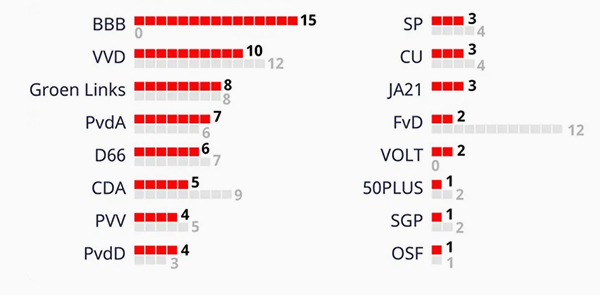

Letters we get from readers often complain about the fact that they get get to choose from only two parties in most elections and they don't like either of them. That's usually not true since in addition to the Democrats and Republicans, the Libertarian Party and the Green Party are on the ballot in many states. In some states, the Constitution Party and other parties are also on the ballot. But be careful what you wish for.
Yesterday there were elections in the Netherlands for the provincial legislatures and the 21 water boards around the country. The provincial legislatures aren't nearly as powerful as U.S. state legislatures, although they choose the members of the upper chamber of the parliament, the Senate, just as in the U.S. prior to the 17th Amendment. The entire upper chamber is chosen all at once every four years. There are no staggered terms, as in the U.S. Senate. Here are the preliminary results:

Sixteen parties are likely to be represented in the 75-member chamber. The red boxes show the results of yesterday's election. The gray ones show the current division of seats (i.e., the results from the 2019 election).
Together, the four biggest parties have 40 seats and thus a majority. However, the four biggest parties don't like each other. The BBB is a new right-of-center party that represents the interests of farmers. The VVD is the main conservative party. Groen Links (literally Green Left) is far to the left of AOC. PvDA is the rough equivalent of the British Labor Party. Getting these folks to agree on anything is out of the question. Imagine that Reps. Jim Banks (R-IN), Kevin McCarthy (R-CA), Ilhan Omar (DFL-MN), and Hakeem Jeffries (D-NY) were the leaders of the four biggest parties in the House and together they had a small majority, with 12 other small parties also there. Could they agree on a legislative program? The upside of having 20-30 parties running for office with 16 having a realistic chance of getting at least one member elected is that voters can pick a party that exactly matches their views. The downside is a massively fragmented legislative chamber.
Putting together a majority will involve cobbling together a coalition with a bunch of small parties, all of whom will demand the sun, the moon, and the stars for their support. The PVV and FvD are quasi-fascist parties, so nobody wants to work with them. The PvdD is the animal rights party. Their goals will be tough for any of the others to swallow. CDA is the Christian party, etc. Each of the small parties has some niche and smaller constituency that cares very passionately about one thing. Do you think the 50PLUS Party (think: the AARP Party) is going to support any agreement that in any way weakens Social Security? Try again. After months of haggling, some coalition will usually be forged, but it is likely to be a different one than the one in the lower chamber, which has more power than the upper chamber. Under these conditions, getting anything done will not be easy. In the U.S., if one party has a working trifecta, in theory at least it could abolish the filibuster and enact its program. That's much harder when the legislative branch is badly fragmented. (V)